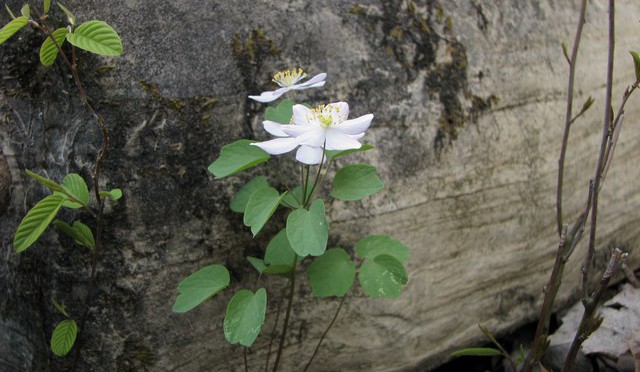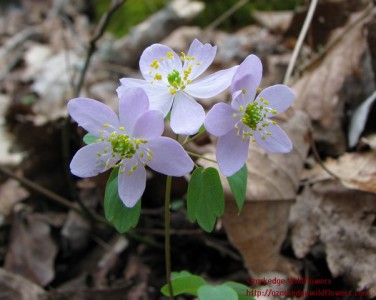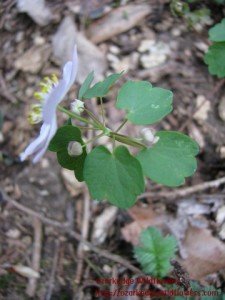Rue anenome is not a flashy, in-your-face kind of a flower. She sits quietly by while everyone’s raving about the Dutchman’s Breeches and the Bloodroots. She knows she’ll get her due–and she does. Yesterday, I went out to get some photos of the Dutchman’s Breeches before they are all gone for the year, and the Rue Anenome was just beautiful. It was a gray, misty day–not the best day for wildflower watching. The Trout Lillies were sulking and refusing to open up. But, Rue Anenome did not care about the weather. Everywhere I looked, she was showing off her faint pink blossoms–demanding my attention. So, I decided it was time to photograph and write about her today.
Latin Name/Common Name- Thalictrum thalictroides is in the Buttercup family (Ranunculaceae). Thalictrum is a Greek word used to describe a plant with divided leaves. If you try to look this plant up in an older book you might have better luck with its’ former Latin name- Anemonella Thalictroides. Rue Anenome is the common name–not to be confused with False Rue Anenome which is a different (but very similar looking) flower.
Bloom Color- The delicate blooms of Rue Anemone vary from a soft pink to white. The younger blooms are darker pink, fading to white with age.
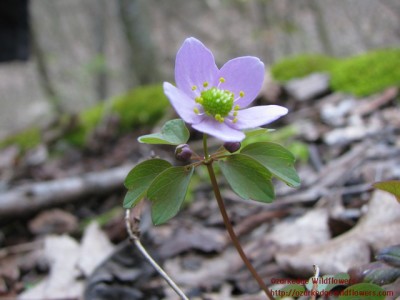 This picture shows a very young bloom that is quite pink
This picture shows a very young bloom that is quite pink
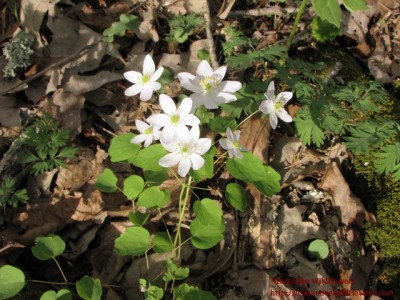 This picture shows blooms of white
This picture shows blooms of white
Description- Rue Anenome is about 7 – 9 inches tall on a single, slender stem. The reddish stem is stronger than it looks because it will hold the whorled leaves and multiple flowers.
Near the top of the plant, just below the flowers, a whorl of 6 leaflets is seen. The presence of whorled leaves is one of the key ways to differentiate Rue Anenome from False Rue Anenome.
Each leaflet has three rounded, lobes.
The number of flower sepals (there are no petals) varies from 5 -10. The False Rue Anenome has only 5 and they are white, not pink.
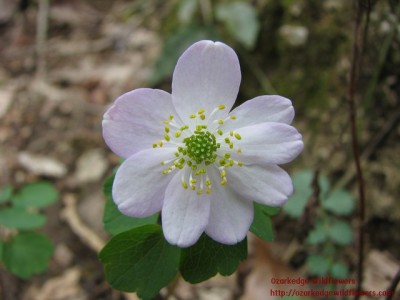 Rue anenome in flower with 8 sepals
Rue anenome in flower with 8 sepals
Bloomtime- Early March is the time to start looking for Rue Anenome. They have a longer blooming time than many of the spring woodland flowers. I’ve documented them blooming until mid May on Ozarkedge.
Habitat- They love the open woods and pop up through the brown oak leaves on the woodland floor. I often find them adjacent to the oak trees–maybe for protection? They must not be too picky about the weather, because they are found from north to south in the eastern half of the United States.
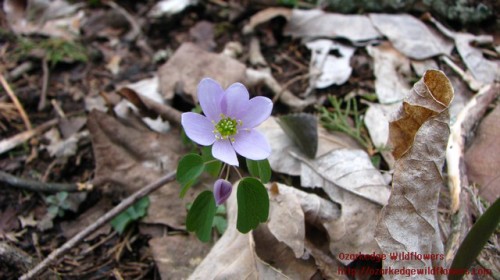 Rue anenome growing through the oak leaves
Rue anenome growing through the oak leaves
Propagation- You can propagate this plant by division. But it is best to gather the ripe seed. It will take about 2-3 years for a seedling to reach maturity and flower. If you buy plants, please make sure you are purchasing them from a reputable nursery that does not dig from the wild. Once you have grown purchased plants, you can divide them after they bloom or, if you marked their location, you can dig in the fall. The tuberous roots resemble the tubers of dahlia.
What’s Growing Neaby? Rue Anenome doesn’t form thick colonies like Trout Lillies or Bloodroot. They just appear here and there in the woods. I don’t see them getting up close and personal with any of the other spring ephemerals. But they aren’t too far away from their woodland friends. Overall, I’ve noticed that they prefer life on a higher site with dryer ground compared to Trout Lillies and Bloodroot.
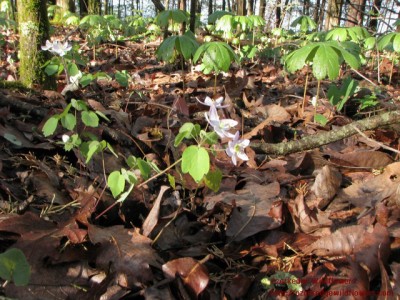 Rue anenome surrounded by May Apples
Rue anenome surrounded by May Apples
Interesting Tidbits- Apparently, the Cherokee made infusions from the roots and used it to treat diarrhea and vomiting. But, I don’t recommend you try this at home.
Endangered List- It’s sad to note that such a sweet flower is listed as Possibly Extirpated in Maine and Endangered in Florida. It is considered Threatened in New Hampshire and is of Special Concern in Rhode Island. You can follow the status at the USDA plant site via this link.
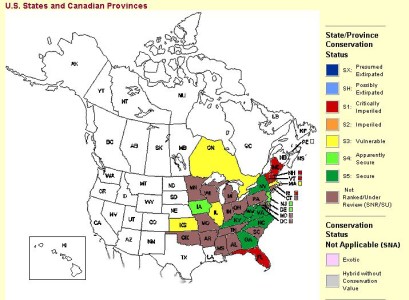 Natureserve shows that Thalictrum thalictroides is Critically imperiled in Maine, Vermont, New Hampshire and Florida. It is Vulnerable in Massachusetts, Illinois and Kansas.
Natureserve shows that Thalictrum thalictroides is Critically imperiled in Maine, Vermont, New Hampshire and Florida. It is Vulnerable in Massachusetts, Illinois and Kansas.
